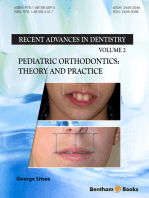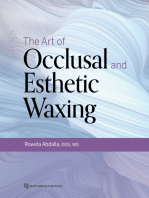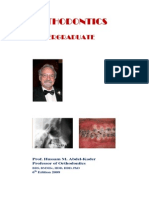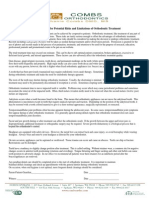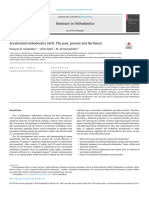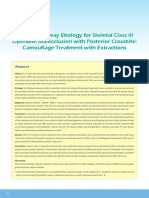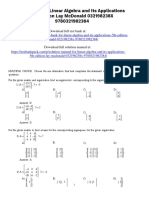1 - FACE Part 1
1 - FACE Part 1
Uploaded by
tamaraCopyright:
Available Formats
1 - FACE Part 1
1 - FACE Part 1
Uploaded by
tamaraOriginal Description:
Original Title
Copyright
Available Formats
Share this document
Did you find this document useful?
Is this content inappropriate?
Copyright:
Available Formats
1 - FACE Part 1
1 - FACE Part 1
Uploaded by
tamaraCopyright:
Available Formats
CLINICAL
Maintaining clearly defined treatment objectives:
part 1
Drs. Domingo Martin and Jorge Ayala demonstrate how to achieve perfect functional and esthetic
outcomes using the FACE Evolution bracket prescription
I n today’s orthodontic treatment of pa-
tients, the outcomes should no longer
simply focus on creating a beautiful smile
by correcting the malocclusion. Regardless
of the patient’s age, the goal should be the
best possible alignment of the teeth to en-
able their integration into a system of cor-
rectly positioned joints, efficient masticatory
function, promotion of a healthy state of the
tooth surrounding tissue, appropriate coor- Figure 1: The four steps of the FACE treatment philosophy
dination of the lips, as well as ideal facial
balance. Clinicians can achieve this with a and later by the RW FACE Initiative (Roth allows for correct diagnosis and treatment
thorough and complete diagnosis that ac- Williams Functional and Cosmetic Excel- planning.
counts for not only the teeth but also the lence) and today’s FACE Group (Functional
joints, a stable condylar position, facial and Cosmetic Excellence), respectively, the Step 2: functional occlusion
esthetics, and optimal muscle function. In focus is on the clinical objective: a functionally (form of occluded dentition)
many instances, that cannot be achieved and esthetically perfect treatment outcome. The posterior teeth should have correct
with orthodontics alone; and therefore, State-of-the-art technology permits even three-dimensional positions so that the
more accurate diagnosis, treatment plan- mandible stays in a stable position. Addi-
close cooperation is necessary between the
ning, and treatment. tionally, the occlusion should have a correct
orthodontist, and the treating dentist and/or
vertical dimension.
colleagues from other specialties.
Treatment philosophy
Step 3: anterior guidance
FACE (Functional and Cosmetic The FACE treatment philosophy harmo-
(form of tooth, vertical and horizontal overbite)
Excellence) nizes facial and dental esthetics, periodontal
The anterior teeth (from canine to canine)
Some time ago, Dr. Ronald H. Roth initi- health, functional occlusion with an ortho-
should have three-dimensionally correct
ated a treatment philosophy based on a pedic stable joint position, open airway, and
positions that maximize good function and
comprehensive orthodontic diagnostic and stable results. It relies on clearly defined treat-
esthetics.
treatment system. The philosophy embraces ment objectives, which are summarized in
the objective evaluation and diagnosis of the the following four steps (Figure 1). Step 4: facial esthetics
jaw position as well as functional occlusion (ideal proportions)
and implementation of treatment based Step 1: proper joint function Realization of steps 1 to 3 finally leads
on this diagnostic information. Based on (form of joints; centric occlusion = centric to step 4, the facial esthetics, whereby the
Roth’s basic principles, which were initially relation [CO=CR]) final treatment represents the best possible
advanced further by the Roth Williams Inter- Clinicians should first check for a stable combination of esthetics, function, and a
national Society of Orthodontists (RWISO) orthopedic position of the joints, which stable orthopedic mandibular position.
Key factors
Dr. Domingo Martin has a BA from the University of Southern California and an MD and DDS from the University of Over the years, the FACE Group has
the Basque Country in Spain. He also earned a Master in Orthodontics from the University of Valencia in Spain. He
is the Director of the FACE/Roth Williams Center for Functional Occlusion for Europe and has postgraduate work in accumulated extensive clinical experience
Bioesthetic Dentistry from the OBI Foundation for Bioesthetic Dentistry. Dr. Martin gives courses and conferences based on numerous studies. This allows defi-
all over the world, and he has a private practice limited to orthodontics in San Sebastián, Spain. He is also a FACE nition of those key factors within the frame-
Member.
work of the FACE treatment philosophy that
Dr. Jorge Ayala has a medical degree from the University of Chile with a specialty in Orthodontics and Maxillary Orthopedics from are crucial for achieving perfect functional
the University of Chile. He is Director of the FACE/Roth Williams Center for Functional Occlusion from Latinoamérica and a professor and esthetic treatment results.
of the FACE/Roth Williams Center for Functional Occlusion in California. He runs a private practice limited to orthodontics in Santiago
de Chile. He is the author of numerous articles and publications and speaker at national and international courses and conferences.
Facial esthetics
Disclosure: Dr. Martin is a consultant for Forestadent. Which tooth movements benefit the
facial esthetics of a patient, and which
24 Orthodontic practice Volume 7 Number 5
CLINICAL
movements tend to have a negative effect
on facial esthetics? Bearing optimal facial
esthetics in mind, as professionals, we are The FACE treatment philosophy harmonizes facial and
able to determine not only the ideal position
of maxilla and mandible, but also the exact
position and torque of the teeth. We also dental esthetics, periodontal health, functional occlusion
can determine the treatment cephalometric
measurements necessary and implement with an orthopedic stable joint position, open airway,
them accordingly.
For example, we know that counter- and stable results.
clockwise rotation of the mandible moves the
mandible and chin forward and shortens the
lower facial height, thus allowing improved
facial esthetics. We also know that facial
asymmetry closely relates to the status of would have a direct effect on the occlusal and detect possible alterations or blockage
the joint, the occlusal function, as well as relationship of the teeth. He also regarded of the upper airway tract at an early stage.
the alignment of the teeth. Clinicians need the condylar shift as a major contributing Additionally, the CBCT images provide
to consider this. factor to unstable treatment outcomes. important information on possible compli-
Okeson suggests that “an orthopedic cations in the maxillary sinus.
Dental esthetics stable joint position (orthopedic stability)
Many factors determine dental esthetics. exists when the stable intercuspal position Stability
For example, the individually correct propor- of the teeth has harmony with the musculo- Regarding the stability of orthodontic
tions of crown length and crown width of the skeletally stable position of the condyles in treatments, numerous studies examine the
anterior teeth have importance. If dispropor- the fossa. When this position exists, func- factors that can contribute to stability, and
tion occurs between length and width — i.e., tional forces can apply to the teeth and joints others promote non-stability. However, no
too square or too long — teeth will distort the without injury.”3 However, if this harmony studies have yet related stability to occlu-
esthetic impression. The length and shape does not exist, Okeson applies the term sion; still, in our experience, stable joint
of the premolars and molars also affect orthopedic instability with overload and injury, positions and harmony between the teeth
esthetics. For example, the mesial buccal such as tooth wear, periodontal changes, and condylar positions play important roles
cusps of the first maxillary molars should and TMJ alterations as the consequences.4 in stability. When this condition exists, the
be more prominent in the dental arch of the Instead of using the term centric relation mandible can open and close on a closure
maxilla than the second molars, as exempli- (CR), we should therefore better focus on the arc without posterior interferences, and
fied by the Roth arch shape. orthopedic stable joint position. no mandibular deflection. Stability also
Clinicians should also consider gingival depends on bilateral protected occlusion
esthetics and the gingival margins, for Periodontal tissues as well as uniform contact on the central
example, when deciding about vertical tooth Stable results can occur only if healthy cusps with forces acting on the long axes
movement or intrusion of the anterior teeth. tissue surrounds the teeth. Clinicians should of the teeth.
When the lips are at rest position, approxi- follow some important rules — e.g., ensuring
mately 3 mm to 4 mm of the incisors should adequate attachment of keratinized gingiva FACE Evolution bracket prescription
show. Also, the incisors should converge prior to any orthodontic tooth movement to Since the introduction of the straight-wire
mesially to the midline and incline labially. avoid recession of the gingiva.5 Epithelial appliance in 1970 by Lawrence F. Andrews,
Dental and facial esthetics form a close attachment, connective tissue, alveolar crest, several prescriptions have arisen that modify
relationship. The dental midlines of the and CEJ should also harmonize. some torque, angulation, and rotational
maxilla and mandible should therefore largely The apices of the teeth should be centered values; however, they basically maintain
correspond to the facial midline. For good within the alveolus to avoid fenestrations, many of Andrews’ original prescription. Even
esthetics, the upper lip should be at the gingival recessions, and root resorption. so, these modifications try to resolve prob-
level of the gingival margin when the patient Ideally, the teeth should be positioned lems in orthodontic biomechanics. Recent
smiles. In contrast, 2 mm to 3 mm of visible at the interproximal bone height and in such developments reveal that variable prescrip-
gingiva would present a perfect full smile. a manner that the forces can be guided tions continue to gain favor in their ability to
The position of the occlusal plane also has adequately and without distracting inter- treat a variety of malocclusions.
importance, and this should lie parallel to the ference and deviation. It is also important Technical progress of the past years has
interpupillary plane. to provide the best possible conditions for opened up new opportunities in diagnos-
performing oral hygiene — i.e., correct inter- tics and treatment planning. Thus, scientific
Functional occlusion proximal contacts with as little crowding as studies using the cone beam computed
Peter E. Dawson,1 Jeffrey P. Okeson,2 possible, appropriate axial positioning of the tomography (CBCT) have shown a significant
and many others have described the impor- teeth, and correction of vertical bone defects. percentage of patients present with dehis-
tant role of the temporomandibular joints in cences and fenestration.
establishing functional occlusion. Roth also Airway Additionally, evaluations using CBCT
recognized the significance of the joints and By using cone beam imaging, we can during the final stages of treatment reveal a
pointed out that any changes to the joints analyze the airway volume of our patients disturbing rate of roots outside the bone in
Volume 7 Number 5 Orthodontic practice 25
CLINICAL
Figures 2A–2D: 2A-2B. Tomography that reveals the radicular position of the maxillary premolars 2 months after inserting a .019” x .025” stainless steel archwire in a bracket with
torque –7°; 2C-2D. The radicular position of the upper canines with straight arch brackets with –2° torque, 2 months after inserting a stainless steel archwire of the same dimension
different sectors of both jaws (Figures 2A-2B).
These disturbing observations give us cause
to critically question negative torque used in
most prescriptions.
We have recently determined the value
of a bracket system that brings us closer
to the aim of a functional and esthetic ideal
treatment outcome — the FACE Evolution
bracket prescription*.
We admire the contribution made by
Andrews as one of the most important
advances for orthodontics, and everything
indicates that the values obtained from his
sample of normal non-orthodontic patients do Figures 3A-3B: Difference between the information supplied in regard to bone by Orthopantomography (3A) and CBCT (3B)
not apply to all orthodontic patients, especially
those presenting poor apical bases and/or
thin periodontium, which is quite common.
We hypothesize that the individuals
studied by Andrews had ideal occlusions,
probably because of their correct basal and
alveolar development, which differs from that
of most patients. When Andrews performed
his research, none of the sophisticated
instrumentarium we can now use existed.
Modification of torque
Extensive clinical research has enabled
us to tackle and resolve problems revealed
on CBCT. Previously, we could not observe
the thickness of the vestibular and lingual
alveolar bone (Figures 3A-3B); CBCT exami-
Figures 4A-4B: Tomography revealing a common situation with canines: a very poor or no vestibular bone, which contra-
nations revealed the mesial and distal bone
indicates any kind of negative torque
levels of the dental roots, and we commonly
see that the vestibular or lingual alveolar bone
limits some tooth movements.
Quite commonly, mandibular incisors
and maxillary and mandibular canines have
compromised alveolar bone.
Torque in the canines
Canines often have thin bone on the
labial and appreciably thicker bone on the
palatal surfaces. Several patients have such
prominent canine radicular prominences that
require unusual treatment plans. Figures 5A-5B: 5A. Clinical picture that clearly shows the radicular prominence and especially delicate periodontal situation
On these occasions, the CBCT reveals a in the maxillary canines. 5B. After using a .019" x .025" rectangular archwire with brackets of torque –2° in the maxillary
thin layer of vestibular cortical bone, and in canines, the radicular problem was increased
26 Orthodontic practice Volume 7 Number 5
CLINICAL
some cases, bone fenestration that contra- effect is greater on the crown than the root, in +6° torqued bracket for mandibular incisors
indicates any radicular vestibular movement patients with fenestrated roots. This enables ideally compensates Class II malocclusions
(Figures 4A-4B, 5A-5B). This common situ- us to attain bone re-coating of the alveolar to give correct position anterior anchorage.
ation caused us to modify torque values –2° defect. Once we obtain the needed effect, The truth is the available alveolar bone will
to +3° for maxillary canines and from –11° we switch the working bracket to a standard determine the bracket chosen.
to –6° for mandibular canines. prescription bracket (+3°) or (–6°). The FACE Evolution bracket chosen
Extreme radicular prominence requires a depends on available bone, teeth in inclina-
bracket with a 20° torque for maxillary and Torque in the lower incisors tion, and the type of movement needed.
mandibular canines. This bracket quickly For the mandibular incisors, FACE
moves the canine root into the thick lingual Evolution has brackets with torque –1° and Torque in the molars
cancellous bone. This excessive torque –6° and can transform into +6° by merely Maxillar molar tubes have required modi-
barely leads to sufficient movement, as its inverting the bracket by –6°. Theoretically, a fication. Orthodontists concerned about
functional occlusion know that premature
contacts in the second molars are common.
Positive molar torque frequently causes
“hanging” palatal cusps, which interfere with
mandibular closure and often lead to lateral
interferences. The problem often forces us to
use transpalatal bars and/or torsion bends
in the archwires.
Clinicians need to remember that manu-
facturing tolerances commonly give us over-
sized brackets and tubes and undersized
wires, which manifests as inefficiencies. One
of the causes of this inefficiency is the play
presented by the arches in the lumen of the
tubes. Several studies have demonstrated
Figures 6A-6B: 6A. Orthopantomography and CBCT. 6B. The CBCT images show the bone limitations for movement of the incisors that this play is because of a slight oversizing
of the slots of the brackets and play of the
tubes, and also the fact that the arches are
slightly smaller than stated by manufacturers
and often even have rounded edges. Tests
performed with tubes from several compa-
nies reveal to us angles of torque loss of up
to 26° with .019" x .025" steel archwires
and up to 11° with .021" x .025" archwires
(Figure 7A).
The FACE Evolution system has devel-
oped maxillary molar tubes. A negative
Figures 7-7B: 7A. Picture of a tube of a known brand that reveals the features of the slot and the lack of rectangular form
of a .019” x .025” steel archwire. Obvious explanation of the lack of efficiency to produce torque. 7B. FORESTADENT tube torque of –30° has been introduced into the
Figures 8A–8C: 8A. Tomography that reveals this clinical situation in a second left maxillary molar, in this case with an appropriate bone for correction of the torque (V = vestibular). 8B.
Tomography revealing the radicular situation to consider during correction of the torque (V = vestibular). 8C. Common situation especially in the maxillary second molars with positive torque,
which leads not only to increased occlusal vertical dimension but also to interference with centric and eccentric mandibular movements
Volume 7 Number 5 Orthodontic practice 27
CLINICAL
maxillary molar tubes. This compensates
for the poor fit of the wire to the tube. Still,
doctors must take special care regarding
available bone since some cases could
contraindicate any kind of movement.
The aim of this modification is not to
attain a torque of –30°, but rather a way of
compensating the torque loss of the arches Figures 9A-9B: Models that reveal the before and after the correction of torque for the 7s
in the tubes.
To summarize, the differences in torque centric relation, present interference with the cases and simultaneously facilitates space
in regard to Roth’s prescription are found in closure. This is especially true of the second closure patients needing minimal or medium
the maxillary and mandibular canines and the molars, which Roth’s philosophy resolves, anchorage.
upper molars. The alternative for the mandib- once the appliances are withdrawn, by using In the next article, we will look at one
ular incisor of –6° and +6° is also added. a gnathologic positioner. of the most interesting aspects of the new
This situation occurs because of the prescription: a bracket that serves not
Rotations loss of alignment of the mesiodistal occlusal only during the working phase, but at the
One attribute of the Roth prescription groove of both the maxillary and mandibular same time, takes into account the finishing
is the excellent anchorage obtained by the first and second molars (Figure 10B). The phase. Another feature introduces the
distal rotation produced in the maxillary and reason for this loss of alignment is found in hybrid possibility — i.e., active in the ante-
mandibular molars. However, this feature, so the distal rotation of 14° in the first molars, rior brackets and passive in the posterior
useful for retrusion of the anterior teeth, turns which has the consequence of an antago- brackets. Last but not least, the working
into a hindrance in two situations: the first, in nistic reciprocal effect in the second molars tubes and working brackets compensate
patients requiring minimal anchorage, espe- as they displace toward the vestibule region. for lack of torque in some cases and reduc-
cially in the mandibular jaw; the second, when This undesired movement occurs when tion of torque in other cases. To finish we
obtaining suitable finishing, and the molar rota- applying positive rotations above 10°, which will show a variety of patient therapies
tion does not enable correct intercuspation ordinary prescriptions have. To solve this where the prescription was used and how
and coordination of the antagonist molars. problem, we use 10° rotation in the maxil- of our goals were achieved. OP
Indeed, virtually 100% of patients lary molars and 0° rotation in the mandibular
treated with this prescription, analyzed in molars. This enables perfect finishing in most * Fa. FORESTADENT
Figures 10A-10B: Occlusal photo that presents correct alignment of the mesiodistal sulci of the molars and premolars, a fundamental aspect to attain correct occlusion. 10A. The tubes used
have a distal rotation of +10°. 10B. Occlusal photo that reveals the misalignment of the marginal ridges of the first and second maxillary molars, with tubes of +14° distal rotation
REFERENCES 7. Roth RH. The maintenance system and occlusal dynamics. Dent Clin North Am.
1976;20(4):761-788.
1. Dawson PE. Functional harmony. In: Dawson PE. Functional Occlusion: From TMJ to Smile
Design. St. Louis, MO: Mosby; 2007. 8. Dawson PE. Functional Occlusion: From TMJ to Smile Design. St. Louis, MO: Mosby; 2007.
2. Okeson JP. Criteria for optimal functional occlusion. In: Okeson JP, ed. Management of 9. Lee RL. Esthetics and its relationship to function. In: Rufenacht C. ed. Fundamentals of
Temporomandibular Disorders and Occlusion. 5th ed. St. Louis, MO: Mosby; 2003. Esthetics. Carol Stream, IL: Quintessence; 1990.
3. Okeson JP. General considerations in occlusal therapy. In: Okeson JP, ed. Management of 10. McNeill C. Fundamental treatment goals. In McNeill C, ed. Science and Practice of Occlusion.
Temporomandibular Disorders and Occlusion. 5th ed. St. Louis, MO: Mosby; 2003. Carol Stream, IL: Quintessence; 1997.
4. Okeson JP. Criteria for optimal functional occlusion. In: Okeson JP, ed. Management of 11. Spear FM. Fundamental occlusal therapy considerations. In: McNeill C, ed. Science and
Temporomandibular Disorders and Occlusion. 5th ed. St. Louis, MO: Mosby; 2003. Practice of Occlusion. Carol Stream, Quintessence, IL; 1997.
5. Roth RH. The Roth functional occlusion approach to orthodontics. Notes from lecture intro- 12. Dawson PE. Functional Occlusion: From TMJ to Smile Design. St. Louis, MO: Mosby; 2007.
ducing the functional occlusion section of the Roth/Williams Center for Functional Occlusion
13. Melsen B, Allais DA. Factors of importance for the development of dehiscences during labial
2-year program.
movement of mandibular incisors: a retrospective study of adult orthodontic patients. Am J
6. Andrews L.A. Straight Wire: The Concept and Appliance. San Diego, CA: LA Wells; 1989. Orthod Dentofacial Orthop. 2005;127(5):552-561.
28 Orthodontic practice Volume 7 Number 5
You might also like
- Bimaxillary ProtrusionDocument13 pagesBimaxillary ProtrusionMahdi ZakeriNo ratings yet
- Equipment Commissioning ProcedureDocument13 pagesEquipment Commissioning ProcedurehiemvaneziNo ratings yet
- Kioti Daedong DK901 Tractor Operator Manual PDFDocument15 pagesKioti Daedong DK901 Tractor Operator Manual PDFfjjsekfkskemeNo ratings yet
- Fixed Orthodontic Appliances: A Practical GuideFrom EverandFixed Orthodontic Appliances: A Practical GuideRating: 1 out of 5 stars1/5 (1)
- Potential and Limitations of Orthodontic Biomechanics RecognizingDocument9 pagesPotential and Limitations of Orthodontic Biomechanics RecognizingLisbethNo ratings yet
- Practical Techniques For Achieving Improved Accuracy in Bracket PositioningDocument14 pagesPractical Techniques For Achieving Improved Accuracy in Bracket Positioninganon-976413No ratings yet
- Nanda Esthetics and Biomechanics 8.12.20Document15 pagesNanda Esthetics and Biomechanics 8.12.20Danial HassanNo ratings yet
- The Secretary and The Effect of New Office Technologies On Record Keeping ManagementDocument12 pagesThe Secretary and The Effect of New Office Technologies On Record Keeping ManagementMorenikeji Adewale33% (3)
- The FACE Book: Functional and Cosmetic Excellence in OrthodonticsFrom EverandThe FACE Book: Functional and Cosmetic Excellence in OrthodonticsNo ratings yet
- Bracket Less OrthodonticsDocument21 pagesBracket Less OrthodonticsIssa Fathima Jasmine.MNo ratings yet
- BiomechanicsDocument33 pagesBiomechanicsMohammed bilalNo ratings yet
- Naish Et Al 2015Document11 pagesNaish Et Al 2015jlkdsjfljsdlfNo ratings yet
- Orthodontic Bonding A Direct ApproachDocument9 pagesOrthodontic Bonding A Direct ApproachAniket PotnisNo ratings yet
- Ricketts Bioprogressive Technique.Document74 pagesRicketts Bioprogressive Technique.ScribdTranslationsNo ratings yet
- When To Use Deprogramming Splint and WhyDocument2 pagesWhen To Use Deprogramming Splint and WhyJustin KimberlakeNo ratings yet
- Biomechanical Implications of Rotation Correction in Orthodontics - Case SeriesDocument5 pagesBiomechanical Implications of Rotation Correction in Orthodontics - Case SeriescempapiNo ratings yet
- Advanced OrthodonticsDocument8 pagesAdvanced OrthodonticsKanchit SuwanswadNo ratings yet
- Evaluation of Knowledge Awareness and Attitude Regarding Clear Aligner Therapy Amongst BDS Interns A Cross Sectional Questionnaire Based SurveyDocument12 pagesEvaluation of Knowledge Awareness and Attitude Regarding Clear Aligner Therapy Amongst BDS Interns A Cross Sectional Questionnaire Based SurveyAthenaeum Scientific PublishersNo ratings yet
- Role of Mini-Implants in OrthodonticsDocument9 pagesRole of Mini-Implants in OrthodonticsRonald WilfredNo ratings yet
- CJM 037Document7 pagesCJM 037DrAshish KalawatNo ratings yet
- Bracket PlacementDocument21 pagesBracket Placementhah263No ratings yet
- Orthodontics Book - ManualDocument82 pagesOrthodontics Book - ManualScribdTranslationsNo ratings yet
- 1.miu - Orthodontics For Undergtaduate 6th Edition On CDDocument219 pages1.miu - Orthodontics For Undergtaduate 6th Edition On CDahmedsyNo ratings yet
- Clinical Review May 2010 PDFDocument25 pagesClinical Review May 2010 PDFAndré Louiz FerreiraNo ratings yet
- TDocument2 pagesTNb100% (1)
- Myths of Orthodontic GnathologyDocument14 pagesMyths of Orthodontic GnathologyJúnior MarotoNo ratings yet
- Informed Consent FormDocument1 pageInformed Consent FormIrina ZumbreanuNo ratings yet
- Made By: Sumera Hashmani Roll Number:38 Jabbar Ahmed Roll Number: 50Document33 pagesMade By: Sumera Hashmani Roll Number:38 Jabbar Ahmed Roll Number: 50Maira HassanNo ratings yet
- Andrew 6 Keys of Occlusion-1Document10 pagesAndrew 6 Keys of Occlusion-1Khan MustafaNo ratings yet
- Class II Division 2 Malocclusion With Deep BiteDocument14 pagesClass II Division 2 Malocclusion With Deep BiteMona CameliaNo ratings yet
- Leaf Expander 2Document41 pagesLeaf Expander 2Alin AniculaesaNo ratings yet
- Bowden1978 Theoretical Considerations of Headgear Therapy 1Document9 pagesBowden1978 Theoretical Considerations of Headgear Therapy 1solodont1100% (1)
- Accelerated Orthodontics (AO) : The Past, Present and The FutureDocument11 pagesAccelerated Orthodontics (AO) : The Past, Present and The FuturesegurahNo ratings yet
- Ortho Lab 1Document11 pagesOrtho Lab 1nightfury200313No ratings yet
- Probable Airway Etiology For Skeletal Class III Openbite Malocclusion With Posterior CrossbiteCamouflage Treatment With Extractions PDFDocument23 pagesProbable Airway Etiology For Skeletal Class III Openbite Malocclusion With Posterior CrossbiteCamouflage Treatment With Extractions PDFHoàng Đức TháiNo ratings yet
- FACE 2 Years Advanced Orthodontics ProgramDocument9 pagesFACE 2 Years Advanced Orthodontics ProgramFace-Course RomaniaNo ratings yet
- Seminars in OrthodonticsDocument3 pagesSeminars in Orthodonticsgriffone1No ratings yet
- Management of Impacted Maxillary Canines Using Mandibular AnchorageDocument4 pagesManagement of Impacted Maxillary Canines Using Mandibular AnchorageplsssssNo ratings yet
- Vit and Hormone in Relation To Growth and Development / Orthodontic Courses by Indian Dental AcademyDocument38 pagesVit and Hormone in Relation To Growth and Development / Orthodontic Courses by Indian Dental Academyindian dental academyNo ratings yet
- Clinical Practice Guidelines Approved 2021 HODDocument57 pagesClinical Practice Guidelines Approved 2021 HODNovaira WaseemNo ratings yet
- Quantification of The Force Systems Delivered by Transpalatal Arches Activated in The Six Burstone GeometriesDocument7 pagesQuantification of The Force Systems Delivered by Transpalatal Arches Activated in The Six Burstone GeometriesImplant DentNo ratings yet
- Impacted Canine: Presented By: Dr. Ahmed Shihab Supervised By: Dr. SarahDocument34 pagesImpacted Canine: Presented By: Dr. Ahmed Shihab Supervised By: Dr. SarahAhmed ShihabNo ratings yet
- Temporary Anchorage Devices in OrthodonticsDocument7 pagesTemporary Anchorage Devices in OrthodonticsGowri ShankarNo ratings yet
- Dimension Vertical, Intrusion y Orto Kokish PDFDocument32 pagesDimension Vertical, Intrusion y Orto Kokish PDFRehabilitación OralNo ratings yet
- DownloadDocument15 pagesDownloadhasan nazzalNo ratings yet
- Dokumen - Tips Principles and Practice of Orthodontics J R e Mills New York 1982 ChurchillDocument1 pageDokumen - Tips Principles and Practice of Orthodontics J R e Mills New York 1982 ChurchillBoom BoomNo ratings yet
- Evolution of Treatment Mechanics and Contemporary Appliance Design in Orthodontics: A 40-Year PerspectiveDocument9 pagesEvolution of Treatment Mechanics and Contemporary Appliance Design in Orthodontics: A 40-Year PerspectiveBeatriz ChilenoNo ratings yet
- A To Z Orthodontics Vol 9 Preventive and Interceptive OrthodonticsDocument38 pagesA To Z Orthodontics Vol 9 Preventive and Interceptive OrthodonticsJosue El Pirruris MejiaNo ratings yet
- Functional Occlusion in Orthodontics: ClinicalDocument11 pagesFunctional Occlusion in Orthodontics: ClinicalNaeem MoollaNo ratings yet
- Growth PredictionDocument101 pagesGrowth PredictionVartika TripathiNo ratings yet
- Atypical Extractions-Oral Surgery / Orthodontic Courses by Indian Dental AcademyDocument36 pagesAtypical Extractions-Oral Surgery / Orthodontic Courses by Indian Dental Academyindian dental academyNo ratings yet
- EWS Rends Rthodontics: A J I T ODocument84 pagesEWS Rends Rthodontics: A J I T OMatias AnghileriNo ratings yet
- Twin BlockDocument130 pagesTwin BlockRolando GamarraNo ratings yet
- Relapse of Anterior Crowding 3 and 2017 American Journal of Orthodontics AnDocument13 pagesRelapse of Anterior Crowding 3 and 2017 American Journal of Orthodontics Andruzair007No ratings yet
- Orthodontic Update - April 2020 PDFDocument54 pagesOrthodontic Update - April 2020 PDFMaria TzagarakiNo ratings yet
- Fixed FunctionalDocument14 pagesFixed FunctionalsuchitraNo ratings yet
- Growth QuesDocument8 pagesGrowth QuesShameer SFsNo ratings yet
- MVT Varsitile +Document28 pagesMVT Varsitile +drimtiyaz123No ratings yet
- Principles of OrthodonticsDocument75 pagesPrinciples of OrthodonticsMichael100% (1)
- User Guide: Huawei Carfi 4GDocument3 pagesUser Guide: Huawei Carfi 4GJNo ratings yet
- Tensores 2Document5 pagesTensores 2enedina1140No ratings yet
- Linear Algebra and Its Applications 5th Edition Lay Test Bank DownloadDocument10 pagesLinear Algebra and Its Applications 5th Edition Lay Test Bank DownloadLaura Mckinnon100% (22)
- Examination of SwellingDocument63 pagesExamination of SwellingBirjesh KumarNo ratings yet
- NARAYANADocument19 pagesNARAYANARuchi_Gupta_7482100% (2)
- Busn 179 Individual ProposalDocument11 pagesBusn 179 Individual Proposalapi-553118940No ratings yet
- 05 HCSA - Hikvision PTZ CameraDocument60 pages05 HCSA - Hikvision PTZ CameraMaerkon Help Desk SupportNo ratings yet
- Risk Management Is The Identification, Evaluation, and Prioritization ofDocument5 pagesRisk Management Is The Identification, Evaluation, and Prioritization ofGowrisanthosh PalikaNo ratings yet
- Gauging Parameters For E-Procurement Acquisition in Construction Businesses in NigeriaDocument11 pagesGauging Parameters For E-Procurement Acquisition in Construction Businesses in NigeriaNaufal S AmaanullahNo ratings yet
- Criterion A: Knowing and Understanding: Arts Assessment Criteria: Year 5Document5 pagesCriterion A: Knowing and Understanding: Arts Assessment Criteria: Year 5Miqk NiqNo ratings yet
- Download Full Introduction to Environmental Engineering 6th Edition Mackenzie Davis PDF All ChaptersDocument40 pagesDownload Full Introduction to Environmental Engineering 6th Edition Mackenzie Davis PDF All Chaptersmomomilabah100% (4)
- O & C Tanker Handout - 221116 - 112754Document230 pagesO & C Tanker Handout - 221116 - 11275465AryanMaheyimu23cNo ratings yet
- Requirements Workshop Tools and TemplatesDocument19 pagesRequirements Workshop Tools and TemplatesJay PatelNo ratings yet
- A New Model For Assessment Fast Food Customer Behavior Case Study: An Iranian Fast-Food RestaurantDocument14 pagesA New Model For Assessment Fast Food Customer Behavior Case Study: An Iranian Fast-Food Restaurantbonavy olingouNo ratings yet
- Engineer and Sosiety Chapter 2Document68 pagesEngineer and Sosiety Chapter 2Wan Snare100% (1)
- Math 443/543 Graph Theory Notes 5: Digraphs, Tra C, and TournamentsDocument3 pagesMath 443/543 Graph Theory Notes 5: Digraphs, Tra C, and TournamentsshubhamNo ratings yet
- Reporting Changes For Cash Aid and CalFresh - Semi-Annual Eligibility Status ReportDocument6 pagesReporting Changes For Cash Aid and CalFresh - Semi-Annual Eligibility Status ReportharshbrandoNo ratings yet
- Galingan, Maureen Joy DDocument2 pagesGalingan, Maureen Joy DLydia D. GalinganNo ratings yet
- Effective Program Management PracticesDocument4 pagesEffective Program Management Practicesrponnan100% (1)
- Rojina InternshipDocument48 pagesRojina Internshipmkc110905No ratings yet
- Microsoft Ucertify 70-640 Dumps V2017-Apr-25 by Susan 612q VceDocument27 pagesMicrosoft Ucertify 70-640 Dumps V2017-Apr-25 by Susan 612q VceRajkumar RamasamyNo ratings yet
- Monash University Problem Based Learning: A New Way of Studying BusinessDocument4 pagesMonash University Problem Based Learning: A New Way of Studying BusinessMonash UniversityNo ratings yet
- Chapter 6 Surface Mine DevelopmentDocument8 pagesChapter 6 Surface Mine DevelopmentCarlos CarridoNo ratings yet
- Class 6 - Week 1 - IT - LP - IcebreakerDocument7 pagesClass 6 - Week 1 - IT - LP - IcebreakerShalaka MainiNo ratings yet
- SCM MPPT Solar Charge Controller 48V100A 300A TelecomDocument2 pagesSCM MPPT Solar Charge Controller 48V100A 300A TelecomRaed Al-HajNo ratings yet
- Map GuascorDocument36 pagesMap GuascorMuhammad Syaqirin0% (1)
- Excavation, Trenching, Shoring Safety TrainingDocument23 pagesExcavation, Trenching, Shoring Safety Trainingfaik395No ratings yet








